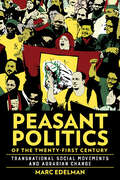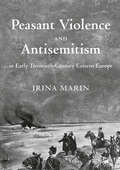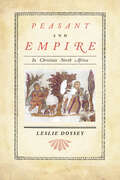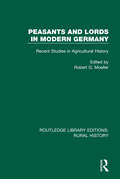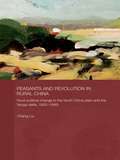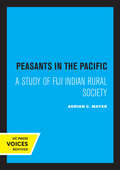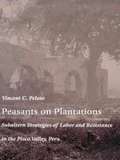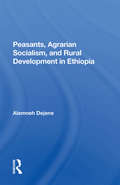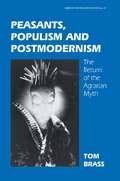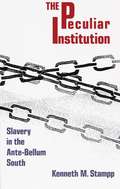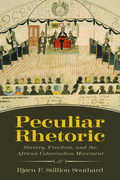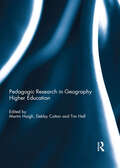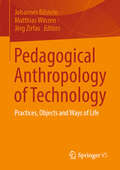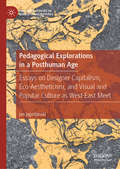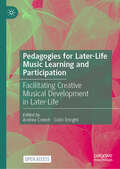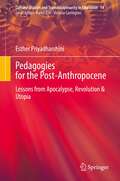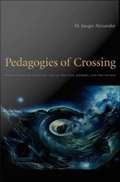- Table View
- List View
Peasant Politics of the Twenty-First Century: Transnational Social Movements and Agrarian Change (Cornell Series on Land: New Perspectives on Territory, Development, and Environment)
by Marc EdelmanPeasant Politics of the Twenty-First Century illuminates the transnational agrarian movements that are remaking rural society and the world's food and agriculture systems. Marc Edelman explains how peasant movements are staking their claims from farmers' fields to massive protests around the world, shaping heated debates over peasants' rights and the very category of "peasant" within the agrarian organizations and in the United Nations.Edelman chronicles the rise of these movements, their objectives, and their alliances with environmental, human rights, women's, and food justice groups. The book scrutinizes high-profile activists and the forgotten genealogies and policy implications of foundational analytical frameworks like "moral economy," and concepts, such as "food sovereignty" and "civil society." Peasant Politics of the Twenty-First Century charts the struggle of agrarian movements in the face of land grabbing, counter agrarian reform, and a looming climate catastrophe, and celebrates engaged research from Central America to the UN Human Rights Council in Geneva.
Peasant Violence and Antisemitism in Early Twentieth-Century Eastern Europe
by Irina MarinThis book is a transnational study of rural and anti-Semitic violence around the triple frontier between Austria-Hungary, Romania and Tsarist Russia at the beginning of the twentieth century. It focuses on the devastating Romanian peasant uprising in 1907 and traces the reverberations of the crisis across the triple frontier, analysing the fears, spectres and knee-jerk reactions it triggered in the borderlands of Austria-Hungary and Tsarist Russia. The uprising came close on the heels of the 1905-1907 social turmoil in Tsarist Russia, and brought into play the major issues that characterized social and political life in the region at the time: rural poverty, the Jewish Question, state modernization, and social upheavals. The book comparatively explores the causes and mechanisms of violence propagation, the function of rumour in the spread of the uprising, land reforms and their legal underpinnings, the policing capabilities of the borderlands around the triple frontier, as well as newspaper coverage and diplomatic reactions.
Peasant and Empire in Christian North Africa (Transformation of the Classical Heritage #47)
by Leslie DosseyThis remarkable history foregrounds the most marginal sector of the Roman population, the provincial peasantry, to paint a fascinating new picture of peasant society. Making use of detailed archaeological and textual evidence, Leslie Dossey examines the peasantry in relation to the upper classes in Christian North Africa, tracing that region's social and cultural history from the Punic times to the eve of the Islamic conquest. She demonstrates that during the period when Christianity was spreading to both city and countryside in North Africa, a convergence of economic interests narrowed the gap between the rustici and the urbani, creating a consumer revolution of sorts among the peasants. This book's postcolonial perspective points to the empowerment of the North African peasants and gives voice to lower social classes across the Roman world.
Peasants and Lords in Modern Germany: Recent Studies in Agricultural History (Routledge Library Editions: Rural History #11)
by Robert G. MoellerThis collection of essays, first published in 1986, provides an exciting introduction to modern German agrarian history. The essays offer a revised account of the agricultural sector in an industrial Germany, and provide an extensive methodological, conceptual and thematic range. This collection challenges accepted interpretations, suggests some alternatives and at the same time offers a context in which new questions can be posed and answers can be sought.
Peasants and Revolution in Rural China: Rural Political Change in the North China Plain and the Yangzi Delta, 1850-1949 (Routledge Studies on the Chinese Economy #5)
by Chang LiuThis book explores rural political change in China from 1850 to 1949 to help us understand China’s transformation from a weak, decaying agrarian empire to a unified, strong nation-state during this period. Based on local gazetteers, contemporary field studies, government archives, personal memoirs and other primary sources, it systematically compares two key macro-regions of rural China – the North China plain and the Yangzi delta – to demonstrate the ways in which the forces of political change, shaped by different local conditions, operated to transform the country. It shows that on the North China plain, the village community composed mainly of owner-cultivators was the focal point for political mobilization, whilst in the Yangzi delta absentee landlordism was exploited by the state for local control and tax extraction. However, these both set the stage, in different ways, for the communist mobilization in the first half of the twentieth century. Peasants and Revolution in Rural China is an important addition to the literature on the history of the Chinese Revolution, and will be of interest to anyone seeking to understand the course of Chinese social and political development.
Peasants in the Pacific: A Study of Fiji Indian Rural Society (International Library Of Sociology Ser.)
by Adrian MayerThis title is part of UC Press's Voices Revived program, which commemorates University of California Press’s mission to seek out and cultivate the brightest minds and give them voice, reach, and impact. Drawing on a backlist dating to 1893, Voices Revived makes high-quality, peer-reviewed scholarship accessible once again using print-on-demand technology. This title was originally published in 1973.
Peasants on Plantations: Subaltern Strategies of Labor and Resistance in the Pisco Valley, Peru
by Vincent PelosoAfter the 1854 abolition of slavery in Peru, a new generation of plantation owners turned to a system of peasant tenantry to maintain cotton production through the use of cheap labor. In Peasants on Plantations Vincent C. Peloso analyzes the changing social and economic relationships governing the production of cotton in the Pisco Valley, a little-studied area of Peru's south coast. Challenging widely held assumptions about the system of relations that tied peasants to the land, Peloso's work examines the interdependence of the planters, managers, and peasants--and the various strategies used by peasants in their struggle to resist control by the owners.Grounded in the theoretical perspectives of subaltern studies and drawing on an extremely complete archive of landed estates that includes detailed regular reports by plantation managers on all aspects of farming life, Peasants on Plantations reveals the intricate ways peasants, managers, and owners manipulated each other to benefit their own interests. As Peloso demonstrates, rather than a simple case of domination of the peasants by the owners, both parties realized that negotiation was the key to successful growth, often with the result that peasants cooperated with plantation growth strategies in order to participate in a market economy. Long-term contracts gave tenants and sharecroppers many opportunities to make farming choices, to assert claims on the land, compete among themselves, and participate in plantation expansion. At the same time, owners strove to keep the peasants in debt and well aware of who maintained ultimate control.Peasants on Plantations offers a largely untold view of the monumental struggle between planters and peasants that was fundamental in shaping the agrarian history of Peru. It will interest those engaged in Latin American studies, anthropology, and peasant and agrarian studies.
Peasants without the Party: Grassroots Movements in Twentieth Century China (Asia And The Pacific Ser.)
by Lucien BiancoExploring one of the most dynamic and contested regions of the world, this series includes works on political, economic, cultural, and social changes in modern and contemporary Asia and the Pacific.The leading specialist on China's twentieth century peasant resistance reexamines, in bold and original ways, the question: Was the Chinese peasantry a revolutionary force? Where most scholarly attention has focused on Communist-led peasant movements, Bianco's story is one of peasant thought and action largely unmediated by modern political parties. This volume pays particular attention to the first half of the twentieth century when peasant-based conflict, ranging from tax and food protests to secret society conflicts, opium struggles, inter-communal conflicts, and tenant protests over rent, was central to nationwide revolutionary processes.
Peasants, Agrarian Socialism, And Rural Development In Ethiopia
by Alemneh DejeneOne of the few systematic field surveys undertaken following the 1975 agrarian reform in Ethiopia, this study analyzes the conditions constraining agricultural productivity of peasant farmers in the Arsi region and examines how farmers view peasant and government organizations established to attain agrarian socialism. Based on data generated through interviews with farmers, peasant association leaders, and extension agents, Dr. Dejene argues that the low prices for agricultural products, shortages of consumer goods, and lack of improvements in farming technology are among the major obstacles to increasing output among peasant farmers. The author also explores the government policy of transforming peasant associations into oollective farming units, which he finds is supported by only one quarter of the farmers interviewed. His study indicates that peasant institutions could best mobilize labor and resources to generate agricultural surplus and undertake conservation activities that would prevent future famine. Thus the author concludes that present government efforts should emphasize strengthening the cooperative movement rather than establishing collective farming.
Peasants, Citizens and Soldiers
by Luuk De LigtRecent years have witnessed an intense debate concerning the size of the population of Roman Italy. This book argues that the combined literary, epigraphic and archaeological evidence supports the theory that early-imperial Italy had about six million inhabitants. At the same time the traditional view that the last century of the Republic witnessed a decline in the free Italian population is shown to be untenable. The main foci of its six chapters are military participation rates, demographic recovery after the Second Punic War, the spread of slavery and the background to the Gracchan land reforms, the fast expansion of Italian towns after the Social War, emigration from Italy and the fate of the Italian population during the first 150 years of the Principate.
Peasants, Populism and Postmodernism: The Return of the Agrarian Myth
by Dr Tom BrassTracing the way in which the agrarian myth has emerged and re-emerged over the past century in ideology shared by populism, postmodernism and the political right, the argument in this book is that at the centre of this discourse about the cultural identity of 'otherness'/ 'difference' lies the concept of and innate 'peasant-ness'. In a variety of contextually-specific discursive forms, the 'old' populism of the 1890s and the nationalism and fascism in Europe, America and Asia during the 1920s and 1930s were all informed by the agrarian myth. The postmodern 'new' populism and the 'new' right, both of which emerged after the 1960s and consolidated during the 1990s, are also structured discursively by the agrarian myth, and with it the ideological reaffirmation of peasant essentialism.
Pecos Bill (Between the Lions)
by Rebecca Grand"Here's a book for Leona," Lionel said. "Sweet Nursery Rhymes for Sleepy Cubs! And here's mine-How Pecos Bill Cleaned Up the West."
Peculiar Attunements: How Affect Theory Turned Musical
by Roger Mathew GrantPeculiar Attunements places the recent turn to affect into conversation with a parallel movement in European music theory of the eighteenth century. During that time the affects—or passions, as they were also called—formed a vital component of a mimetic model of the arts. Eighteenth-century critics held that artworks imitated or copied the natural world in order to produce copies of the affects in their beholders. But music caused a problem for such theories, since it wasn’t apparent that musical tones could imitate anything with any dependability, beyond the rare thunderclap or birdcall.Struggling to articulate how it was that music managed to move its auditors without imitation, certain theorists developed a new affect theory crafted especially for music, postulating that music’s physical materiality as sound vibrated the nerves of listeners and attuned them to the affects through sympathetic resonance. This was a theory of affective attunement that bypassed the entire structure of representation, offering a non-discursive, corporeal alternative. It is a pendant to contemporary theories of affect, and one from which they have much to learn. Inflecting our current intellectual moment through eighteenth-century music theory and aesthetics, this book offers a reassessment of affect theory’s common systems and processes. It offers a new way of thinking through affect dialectically, drawing attention to patterns and problems in affect theory that we have been given to repeating. Finally, taking a cue from eighteenth-century theory, it gives renewed attention to the objects that generate affects in subjects.
Peculiar Institution: Slavery in the Ante-bellum South
by Kenneth M. StamppPrior to the Civil War southern slavery was America's most profound and vexatious social problem. More than any other problem, slavery nagged at the public conscience; offering no easy solution, it demanded statesmanship of uncommon vision, wisdom, and boldness. This institution deserves close study if only because its impact upon the whole country was so disastrous
Peculiar Places: A Queer Crip History of White Rural Nonconformity
by Ryan Lee CartwrightThe queer recluse, the shambling farmer, the clannish hill folk—white rural populations have long disturbed the American imagination, alternately revered as moral, healthy, and hardworking, and feared as antisocial or socially uncouth. In Peculiar Places, Ryan Lee Cartwright examines the deep archive of these contrary formations, mapping racialized queer and disability histories of white social nonconformity across the rural twentieth-century United States. Sensationalized accounts of white rural communities’ aberrant sexualities, racial intermingling, gender transgressions, and anomalous bodies and minds, which proliferated from the turn of the century, created a national view of the perversity of white rural poverty for the American public. Cartwright contends that these accounts, extracted and estranged from their own ambivalent forum of community gossip, must be read in kind: through a racialized, materialist queercrip optic of the deeply familiar and mundane. Taking in popular science, documentary photography, news media, documentaries, and horror films, Peculiar Places orients itself at the intersections of disability studies, queer studies, and gender studies to illuminate a racialized landscape both profoundly ordinary and familiar.
Peculiar Places: A Queer Crip History of White Rural Nonconformity
by Ryan Lee CartwrightThe queer recluse, the shambling farmer, the clannish hill folk—white rural populations have long disturbed the American imagination, alternately revered as moral, healthy, and hardworking, and feared as antisocial or socially uncouth. In Peculiar Places, Ryan Lee Cartwright examines the deep archive of these contrary formations, mapping racialized queer and disability histories of white social nonconformity across the rural twentieth-century United States. Sensationalized accounts of white rural communities’ aberrant sexualities, racial intermingling, gender transgressions, and anomalous bodies and minds, which proliferated from the turn of the century, created a national view of the perversity of white rural poverty for the American public. Cartwright contends that these accounts, extracted and estranged from their own ambivalent forum of community gossip, must be read in kind: through a racialized, materialist queercrip optic of the deeply familiar and mundane. Taking in popular science, documentary photography, news media, documentaries, and horror films, Peculiar Places orients itself at the intersections of disability studies, queer studies, and gender studies to illuminate a racialized landscape both profoundly ordinary and familiar.
Peculiar Places: A Queer Crip History of White Rural Nonconformity
by Ryan Lee CartwrightThe queer recluse, the shambling farmer, the clannish hill folk—white rural populations have long disturbed the American imagination, alternately revered as moral, healthy, and hardworking, and feared as antisocial or socially uncouth. In Peculiar Places, Ryan Lee Cartwright examines the deep archive of these contrary formations, mapping racialized queer and disability histories of white social nonconformity across the rural twentieth-century United States. Sensationalized accounts of white rural communities’ aberrant sexualities, racial intermingling, gender transgressions, and anomalous bodies and minds, which proliferated from the turn of the century, created a national view of the perversity of white rural poverty for the American public. Cartwright contends that these accounts, extracted and estranged from their own ambivalent forum of community gossip, must be read in kind: through a racialized, materialist queercrip optic of the deeply familiar and mundane. Taking in popular science, documentary photography, news media, documentaries, and horror films, Peculiar Places orients itself at the intersections of disability studies, queer studies, and gender studies to illuminate a racialized landscape both profoundly ordinary and familiar.
Peculiar Rhetoric: Slavery, Freedom, and the African Colonization Movement (Race, Rhetoric, and Media Series)
by Bjorn F. Stillion SouthardWinner of the 2020 Marie Hochmuth Nichols Award from the Public Address Division of the National Communication AssociationThe African colonization movement occupies a troubling rhetorical territory in the struggle for racial equality in the United States. For white colonizationists, the movement seemed positioned as a welcome compromise between slavery and abolition. For free blacks, colonization offered the hope of freedom, but not within America’s borders. Bjørn F. Stillion Southard indicates how politics and identity were negotiated amid the intense public debate on race, slavery, and freedom in America. Operating from a position of power, white advocates argued that colonization was worthy of massive support from the federal government. Stillion Southard pores over the speeches of Henry Clay, Elias B. Caldwell, and Abraham Lincoln, which engaged with colonization during its active deliberation. Between Clay’s and Caldwell’s speeches at the founding of the American Colonization Society (ACS) in 1816 and Lincoln’s final public effort to encourage colonization in 1862, Stillion Southard analyzes the little-known speeches and writings of free blacks who wrestled with colonization’s conditional promises of freedom. He examines an array of discourses to probe the complex issues of identity confronting free blacks who attempted to meaningfully engage in colonization efforts. From a peculiarly voiced “Counter Memorial” against the ACS to the letters of wealthy black merchant Louis Sheridan negotiating for his passage to Liberia to the civically minded orations of Hilary Teage in Liberia, Stillion Southard brings to light the intricate rhetoric of blacks who addressed colonization to Africa.
Pedagogic Research in Geography Higher Education
by Martin Haigh, Debby Cotton and Tim HallThere are many books about teaching in Geography, but this is the first dealing specifically with Pedagogic Research, its methods and practices. Pedagogy research concerns the processes of learning and the development of learners. It is a learner-centred activity that aims to evaluate and improve the ways that students learn and learn to manage, control and comprehend their own learning processes, first as Geographers in Higher Education but equally as future educated citizens. This book collects together some key research papers from the Journal of Geography in Higher Education. They concern original research and critical perspectives on how Geographers learn, critical evaluations of both new and traditional frameworks and methods used for Pedagogic research in Geography, and some case studies on the promotion of self-authorship, learner autonomy, in key Geography Higher Education contexts such as fieldwork and undergraduate project work.This book is a compilation of articles from various issues of the Journal of Geography in Higher Education.
Pedagogical Anthropology of Technology: Practices, Objects and Ways of Life
by Johannes Bilstein Jörg Zirfas Matthias WinzenThe volume examines the question of which specifically educational techniques are required in view of the increasing establishment and professionalization of pedagogical fields of work. In this context, an attempt is made to clarify what pedagogical and didactic preparation must take place for an increasingly technically oriented world. In addition, the everyday techniques of self-care are analyzed. And finally, pedagogical anthropology is also concerned with the question of who is the subject and object of technology.
Pedagogical Explorations in a Posthuman Age: Essays on Designer Capitalism, Eco-Aestheticism, and Visual and Popular Culture as West-East Meet (Palgrave Studies in Educational Futures)
by jan jagodzinskiThis book problematizes the role of education in an increasingly mediatized world through the lenses of creativity, new media, and consumerism. At the core of the issue, the author argues, creativity in art education is being co-opted to serve the purposes of current economic trends towards designer capitalism. Using an East meets West approach, jagodzinski draws on Deleuze and Guattarian philosophy to explore visual and popular culture in Korean society, addressing the tensions that exist between designer education and art that explores the human condition. In doing so, he challenges art educators to envision a new paradigm for education which questions established media ontologies and incorporates new ways to confront the crisis of the Anthropocene.
Pedagogical Opportunities of the Review Genre: Learning in Cultures of Evaluation (Routledge Research in Media Literacy and Education)
by Maarit JaakkolaPedagogical Opportunities of the Review Genre unleashes the pedagogical potential of the review genre, reframing the act of reviewing of cultural products as a communicative practice from a pedagogical perspective.Negotiating between traditions of journalism and media studies and pedagogy, the author presents a novel approach that will increase the readers’ understanding of an activity that is on the increase in an era where 'everyone can be a critic'. She identifies, describes, and develops genre-based pedagogies in formal, non-formal, and informal contexts of learning and teaching, in order to recontextualize the review as a form of learning and rethink of its potential as an inclusive, engaging, and a transformative critical cultural practice.This innovative and truly interdisciplinary study will interest students and researchers in the areas of media literacy, digital media, media and communication studies, cultural studies, sociology of arts, and pedagogical studies – in particular, cultural journalism and criticism, audience studies, cultural production, and cultural mediation, as well as critical media pedagogy and literacy studies.
Pedagogies for Later-Life Music Learning and Participation: Facilitating Creative Musical Development in Later-Life
by Andrea Creech Colin EnrightThis open access book presents evidence-based participant and facilitator perspectives on later-life music learning and participation. The chapters explore the principles and practices that can facilitate and support meaningful music-making in a range of non-formal later-life contexts, highlighting consistent as well as context-specific pedagogical issues. Case study examples are used to examine issues relating to pedagogy as improvisation, the use of technology to support creativity and meaningful music experience, facilitation of the use of music for creativity, sense of belonging, musical identities and musical development in later-life, and more. The book concludes with an innovative and creative pedagogical model to support critical reflection on values, frameworks, and practices in later-life music learning and participation. The book will be accessible and relevant for music researchers and educators, music education students and community music leaders alike.
Pedagogies for the Post-Anthropocene: Lessons from Apocalypse, Revolution & Utopia (Cultural Studies and Transdisciplinarity in Education #14)
by Esther PriyadharshiniThis book draws on posthumanist critique and post qualitative approaches to research to examine the pedagogies offered by imaginaries of the future. Starting with the question of how education can be a process for imagining and desiring better futures that can shorten the Anthropocene, it speaks to concerns that are relevant to the fields of education, youth and futures studies. This book explores lessons from the imaginaries of apocalypse, revolution and utopia, drawing on research from youth(ful) perspectives in a context when the narrative of ‘youth despair’ about the future is becoming persistent. It investigates how the imaginary of 'Apocalypse' acts as a frame of intelligibility, a way of making sense of the monstrosities of the present and also instigates desires to act in different ways. Studying the School Climate Strikes of 2019 as 'Revolution' moves us away from the teleologies of capitalist consumption and endless growth to newer aesthetics. The strikes function as a public pedagogy that creates new publics that include life beyond the human. Finally, the book explores how the Utopias of Afrofuturist fiction provides us with a kind of 'investable' utopia because the starting point is in racial, economic and ecological injustice. If the Apocalypse teaches us to recognize what needs to go, and Revolution accepts that living with ‘less than’ is necessary, then this kind of Utopia shows us how becoming ‘more than’ human may be the future.
Pedagogies of Crossing: Meditations on Feminism, Sexual Politics, Memory, and the Sacred
by M. Jacqui AlexanderM. Jacqui Alexander is one of the most important theorists of transnational feminism working today. Pedagogies of Crossing brings together essays she has written over the past decade, uniting her incisive critiques, which have had such a profound impact on feminist, queer, and critical race theories, with some of her more recent work. In this landmark interdisciplinary volume, Alexander points to a number of critical imperatives made all the more urgent by contemporary manifestations of neoimperialism and neocolonialism. Among these are the need for North American feminism and queer studies to take up transnational frameworks that foreground questions of colonialism, political economy, and racial formation; for a thorough re-conceptualization of modernity to account for the heteronormative regulatory practices of modern state formations; and for feminists to wrestle with the spiritual dimensions of experience and the meaning of sacred subjectivity. In these meditations, Alexander deftly unites large, often contradictory, historical processes across time and space. She focuses on the criminalization of queer communities in both the United States and the Caribbean in ways that prompt us to rethink how modernity invents its own traditions; she juxtaposes the political organizing and consciousness of women workers in global factories in Mexico, the Caribbean, and Canada with the pressing need for those in the academic factory to teach for social justice; she reflects on the limits and failures of liberal pluralism; and she presents original and compelling arguments that show how and why transgenerational memory is an indispensable spiritual practice within differently constituted women-of-color communities as it operates as a powerful antidote to oppression. In this multifaceted, visionary book, Alexander maps the terrain of alternative histories and offers new forms of knowledge with which to mold alternative futures.
